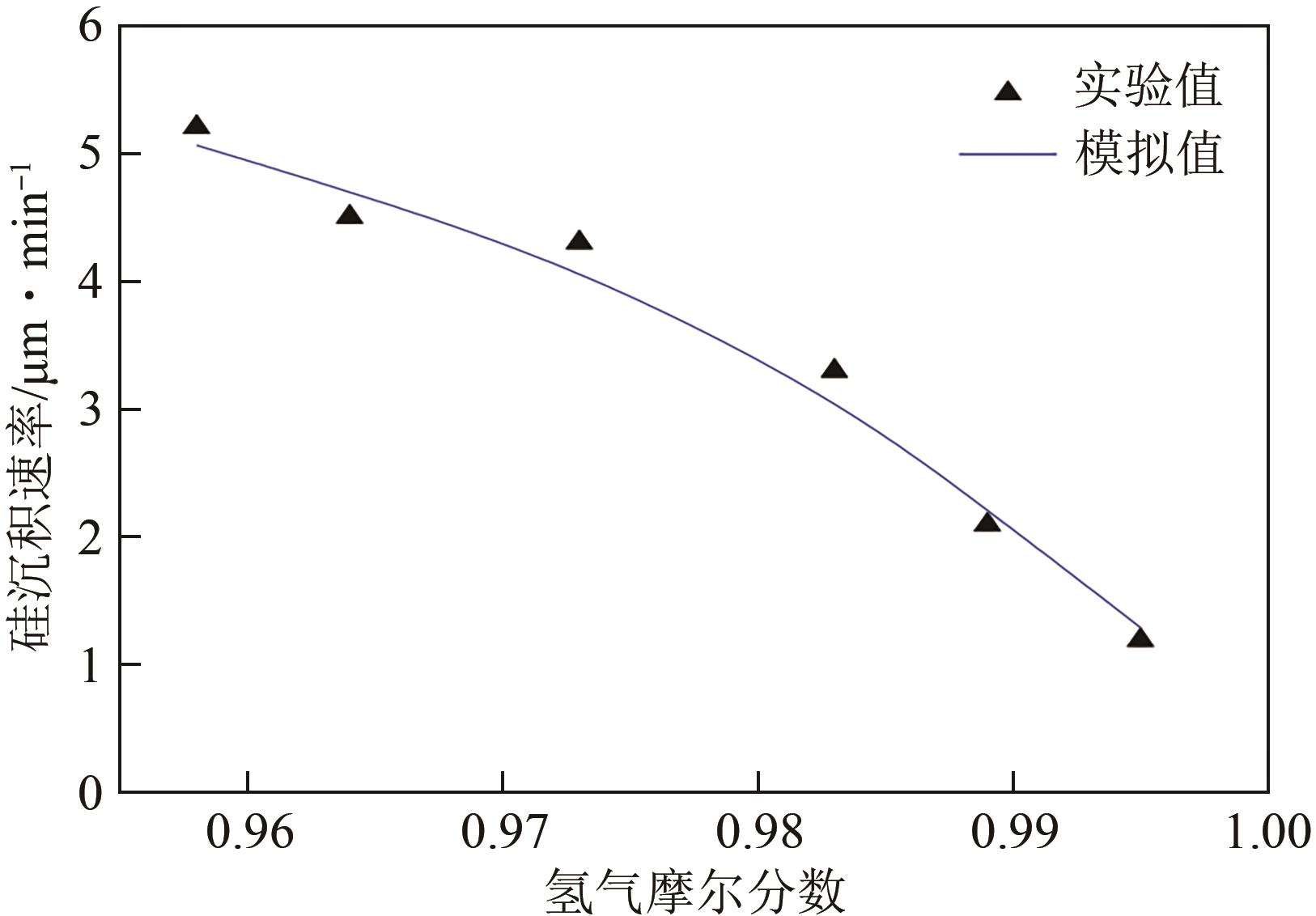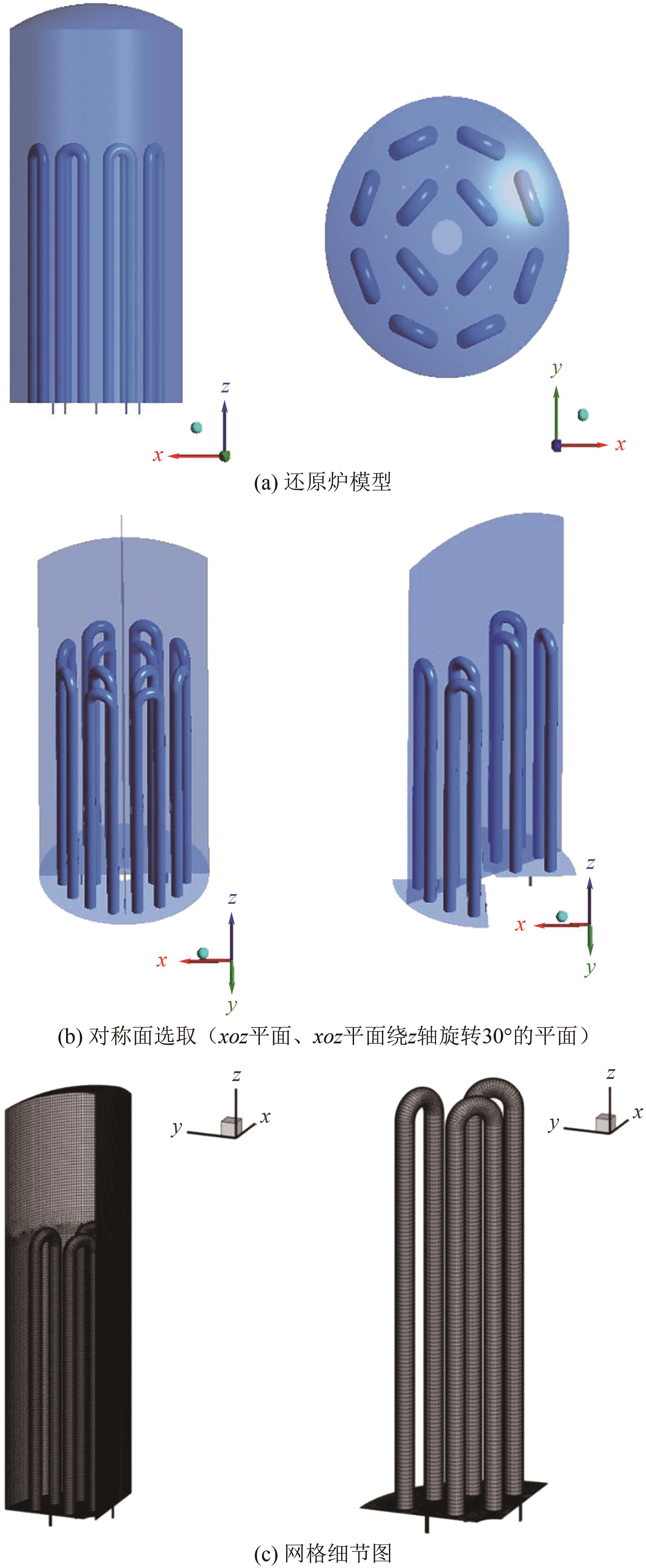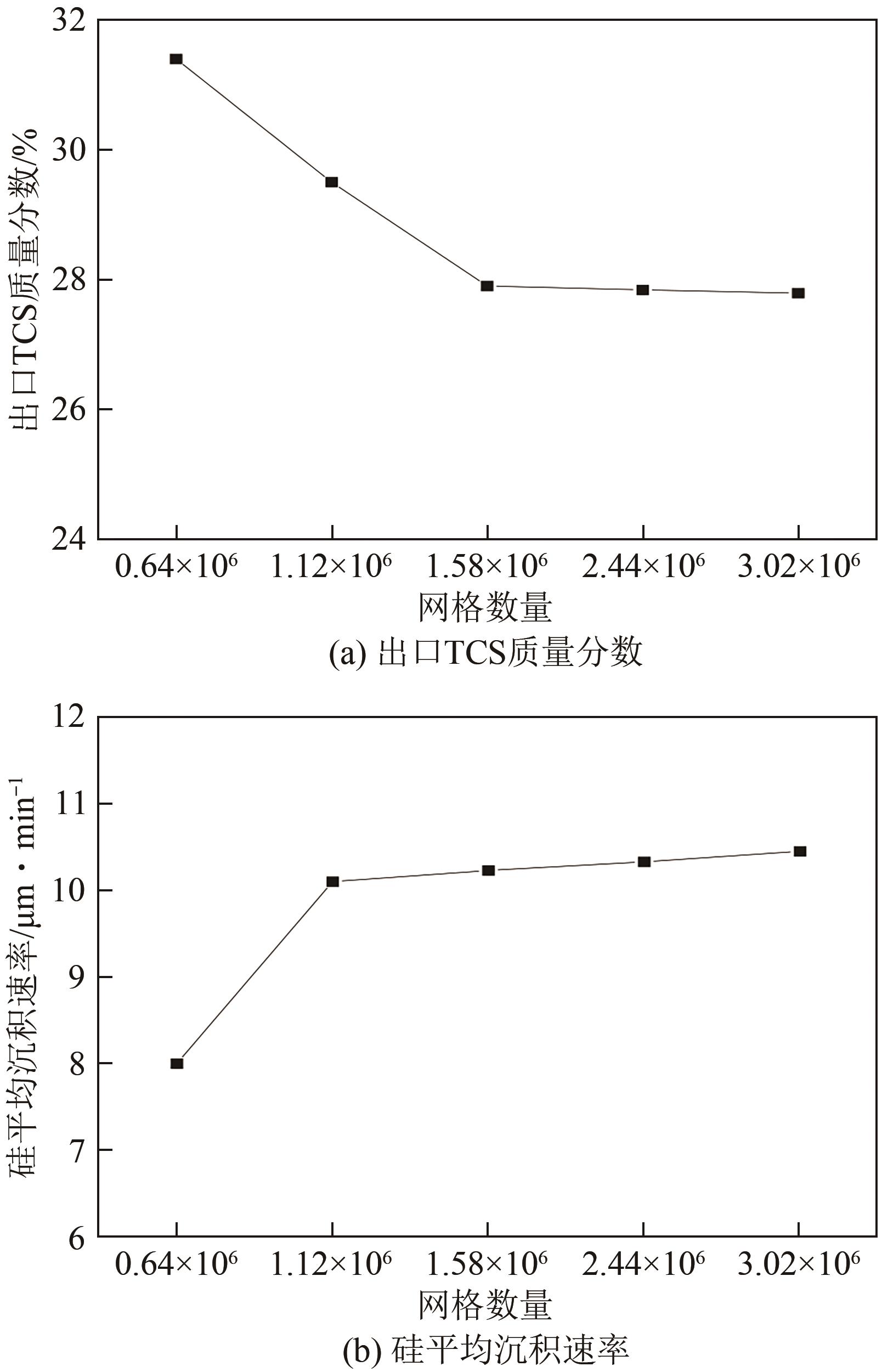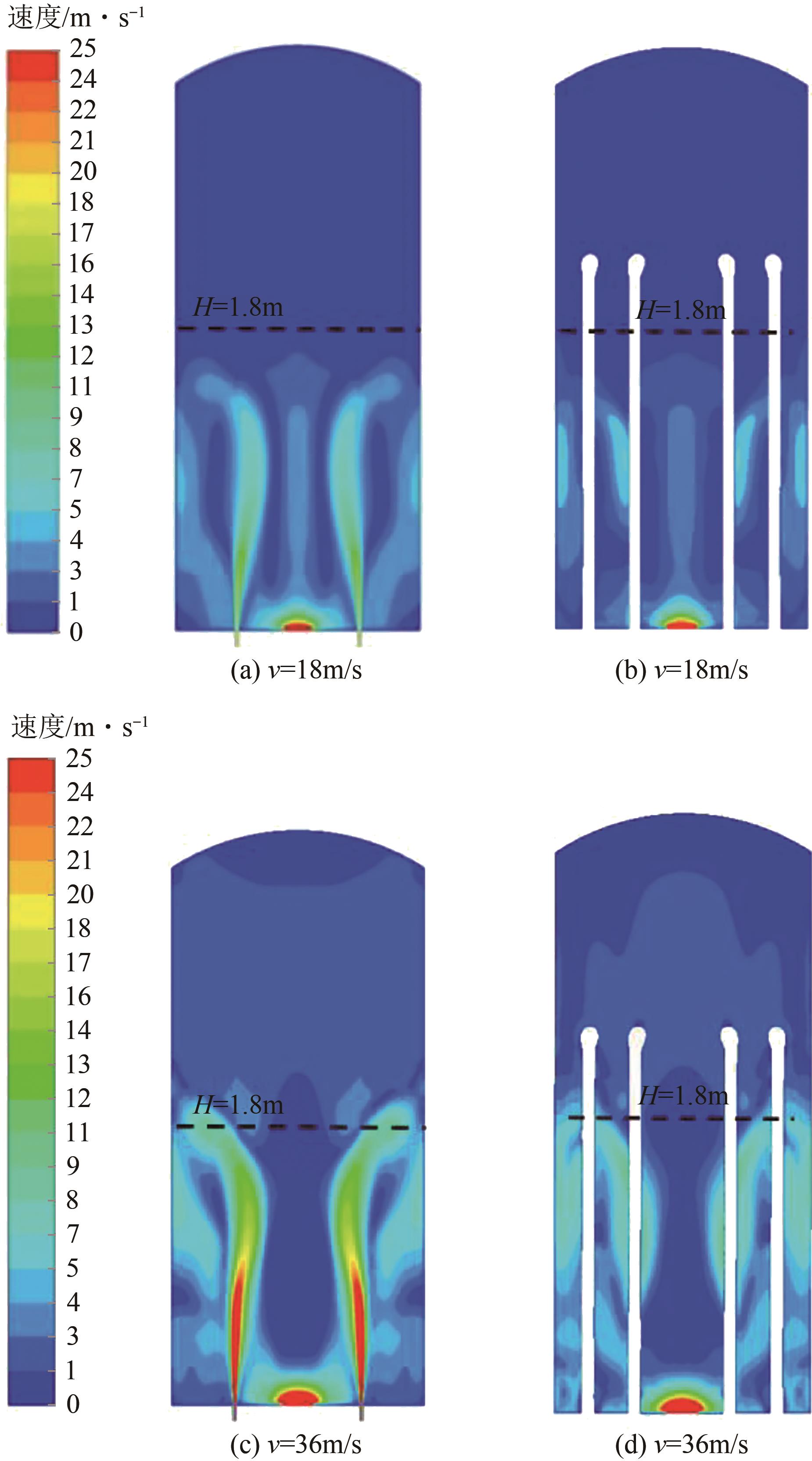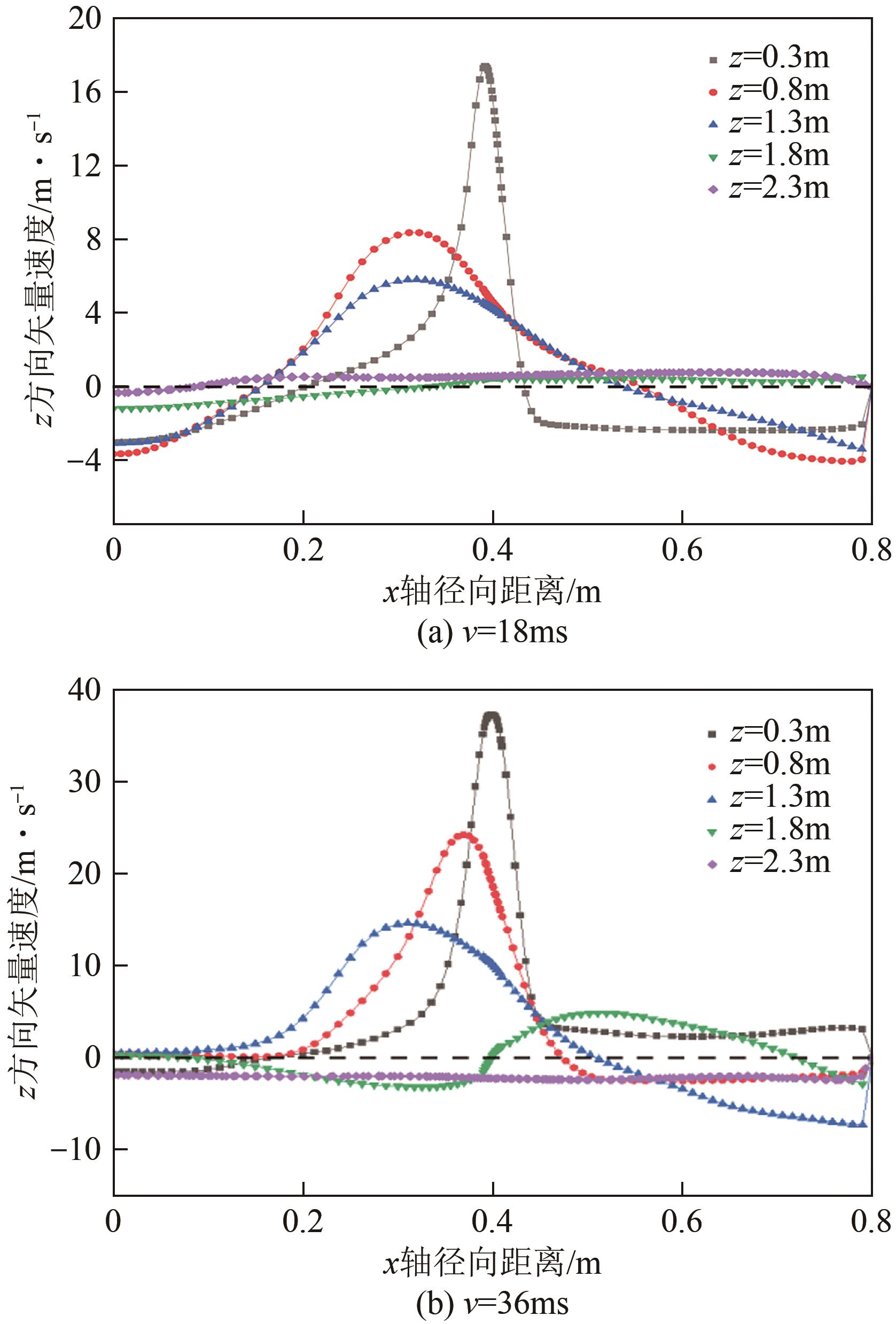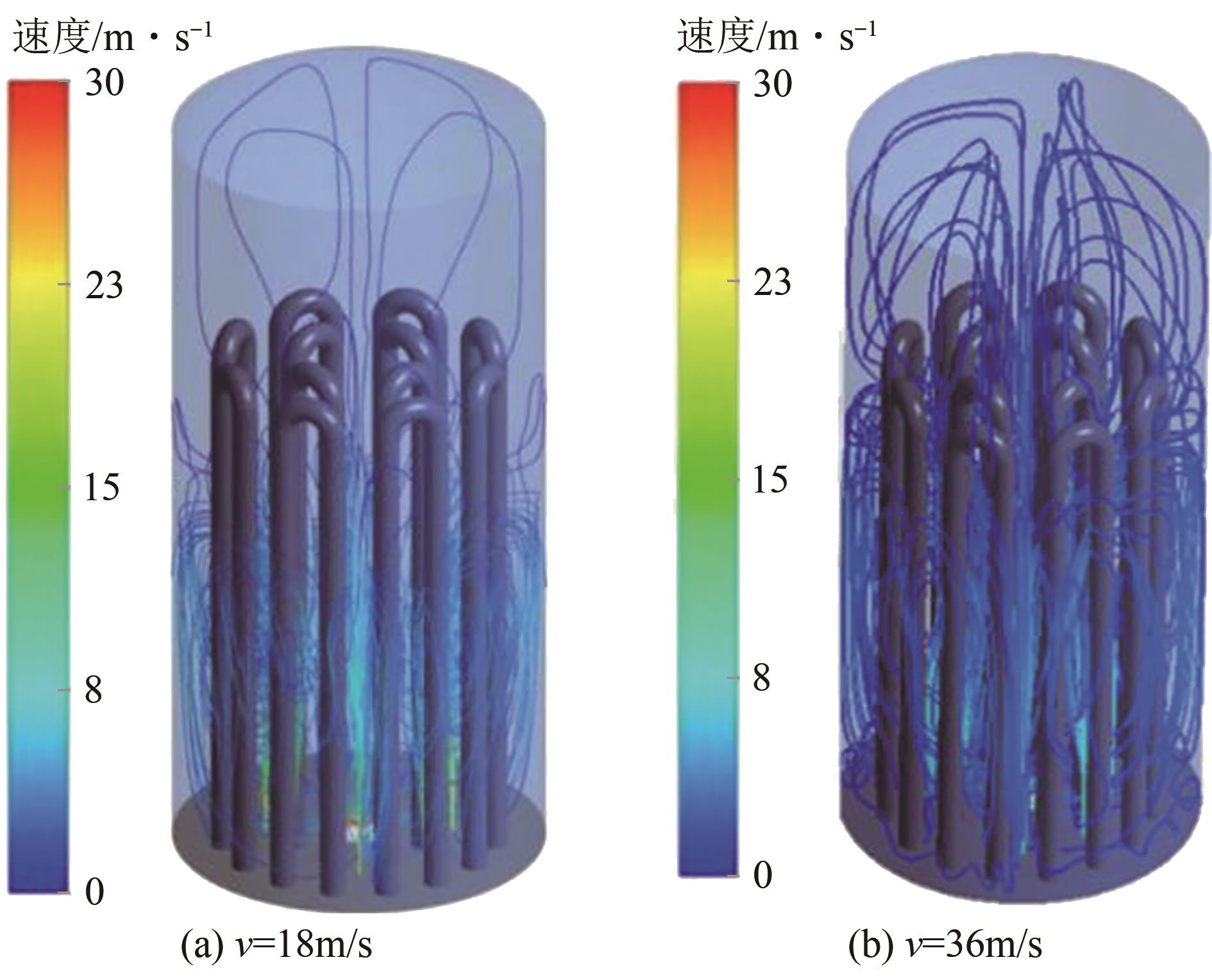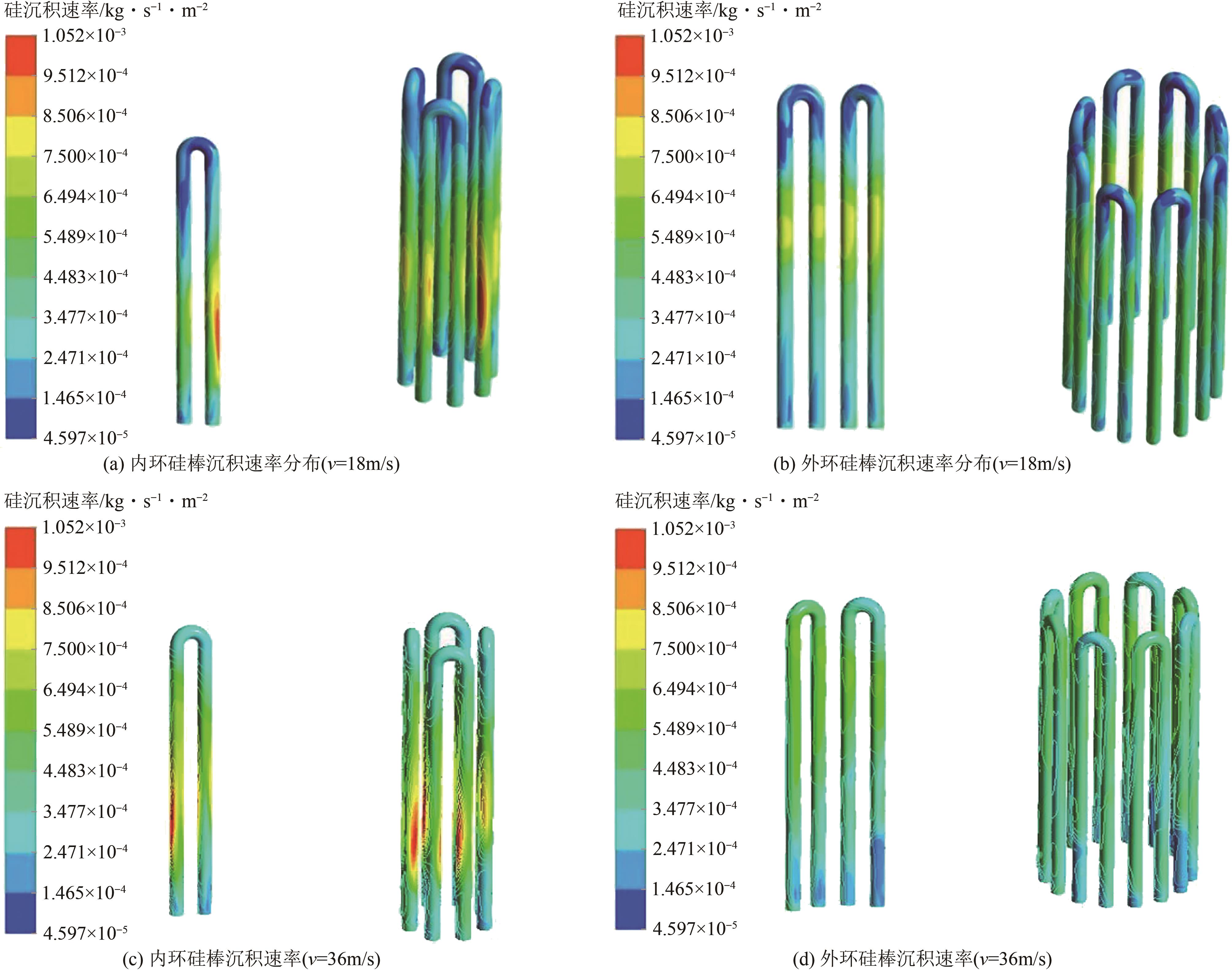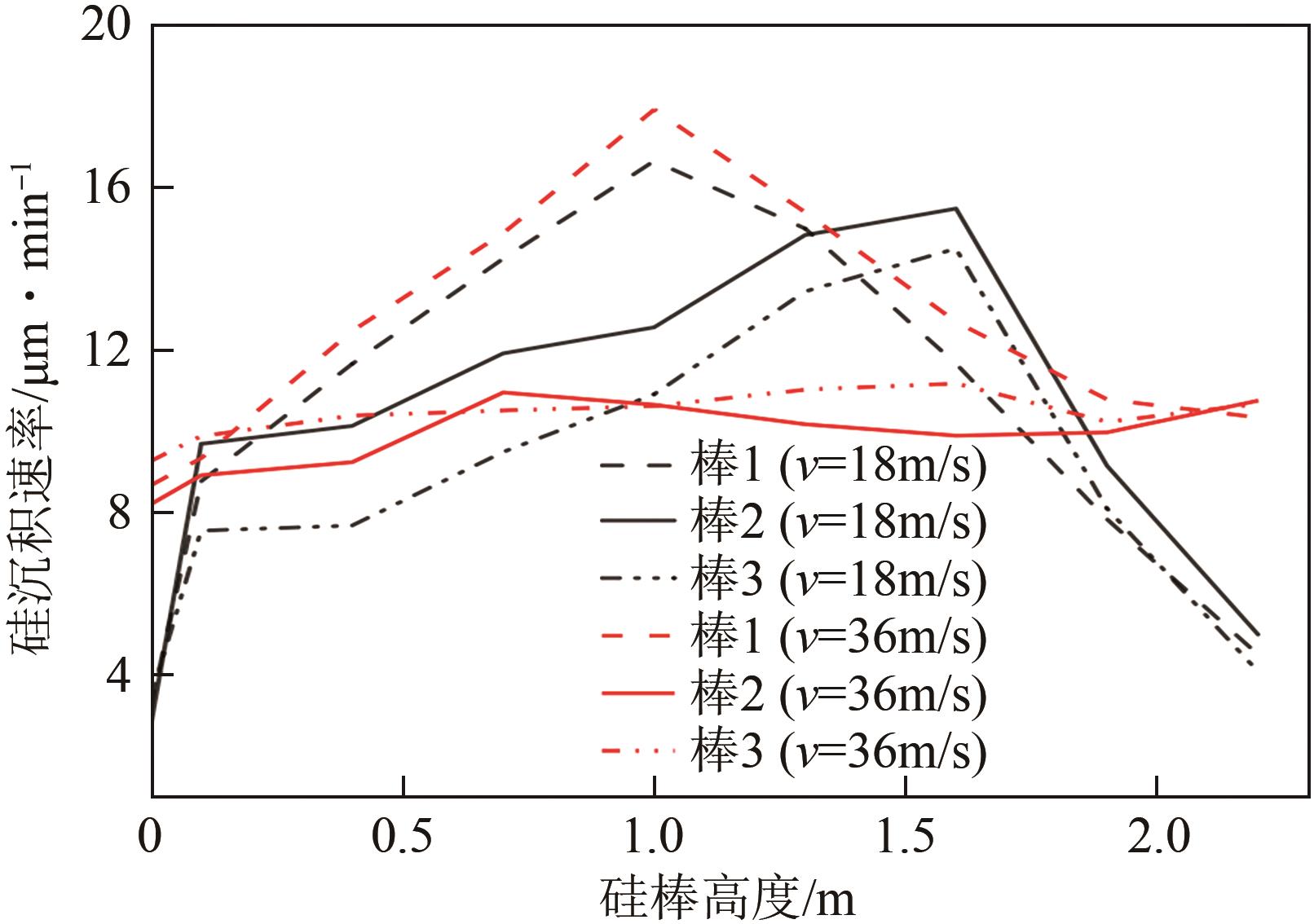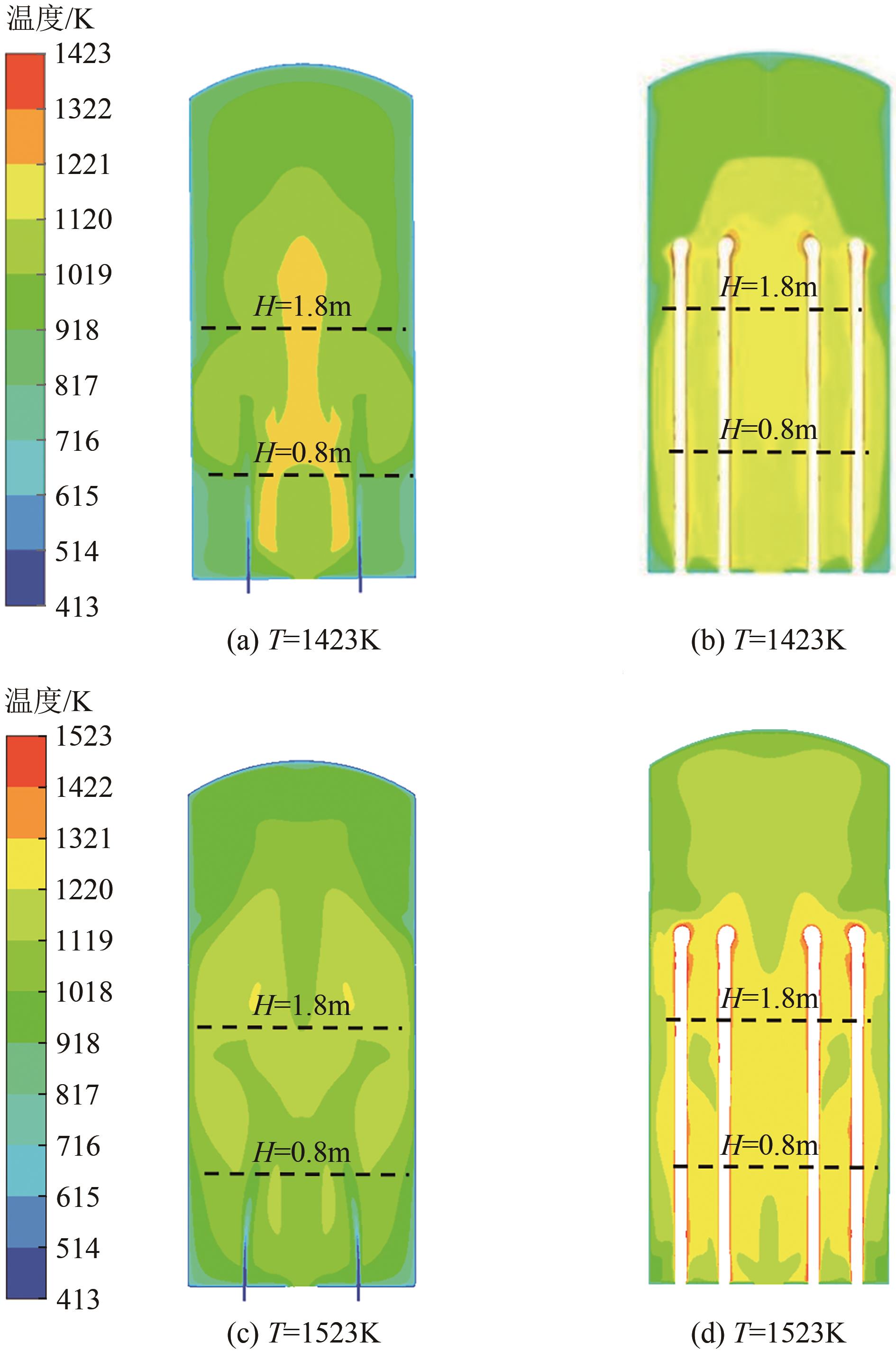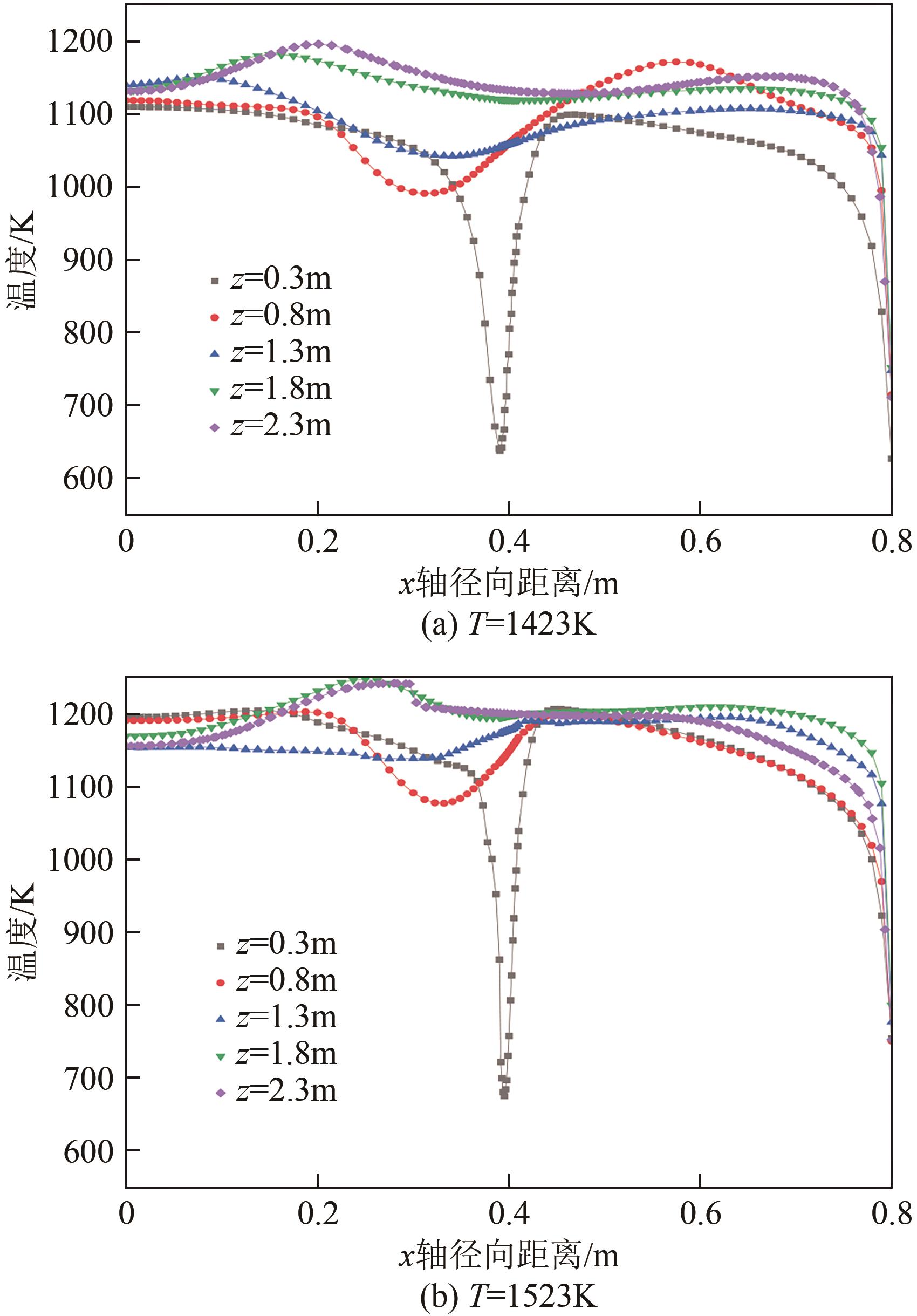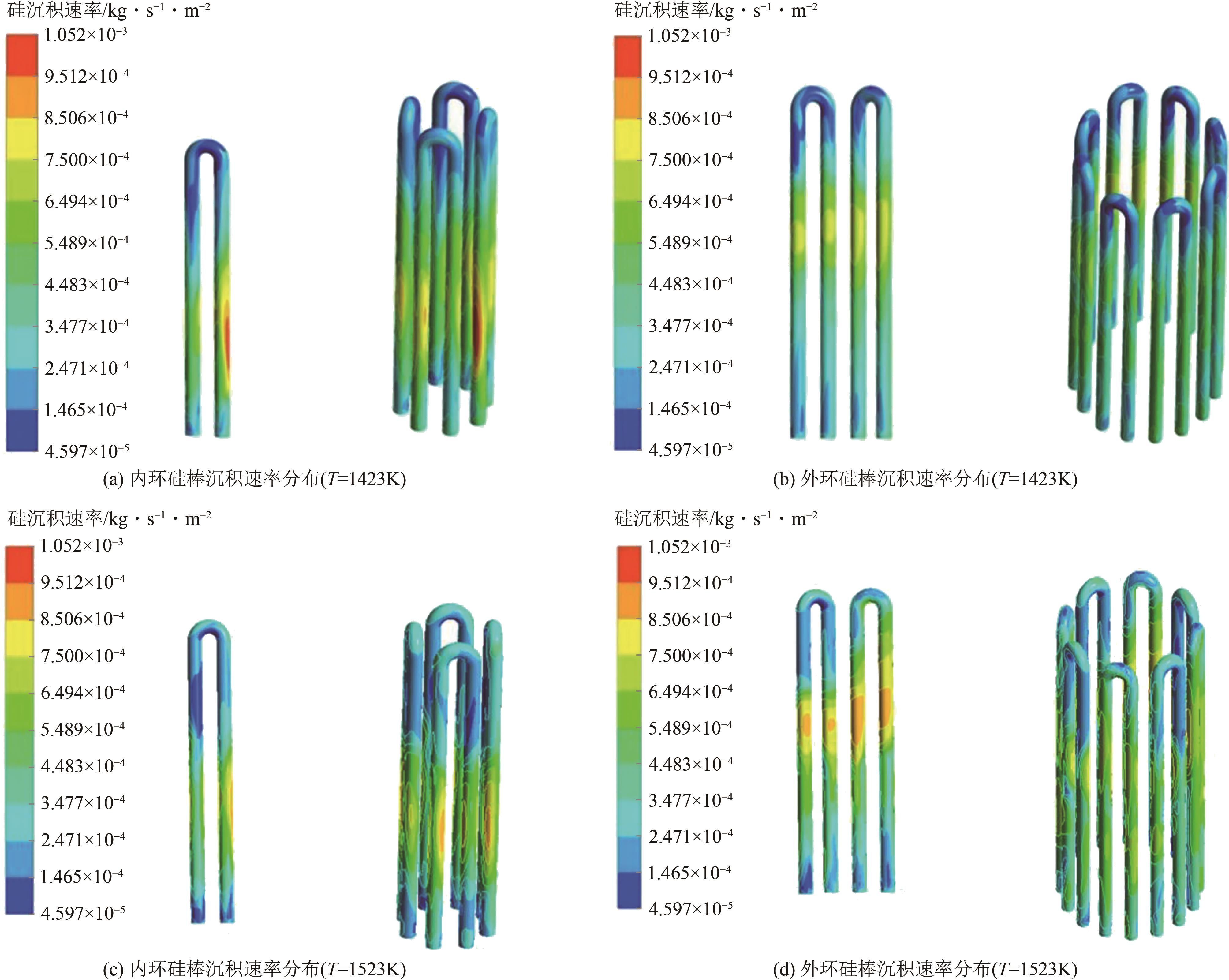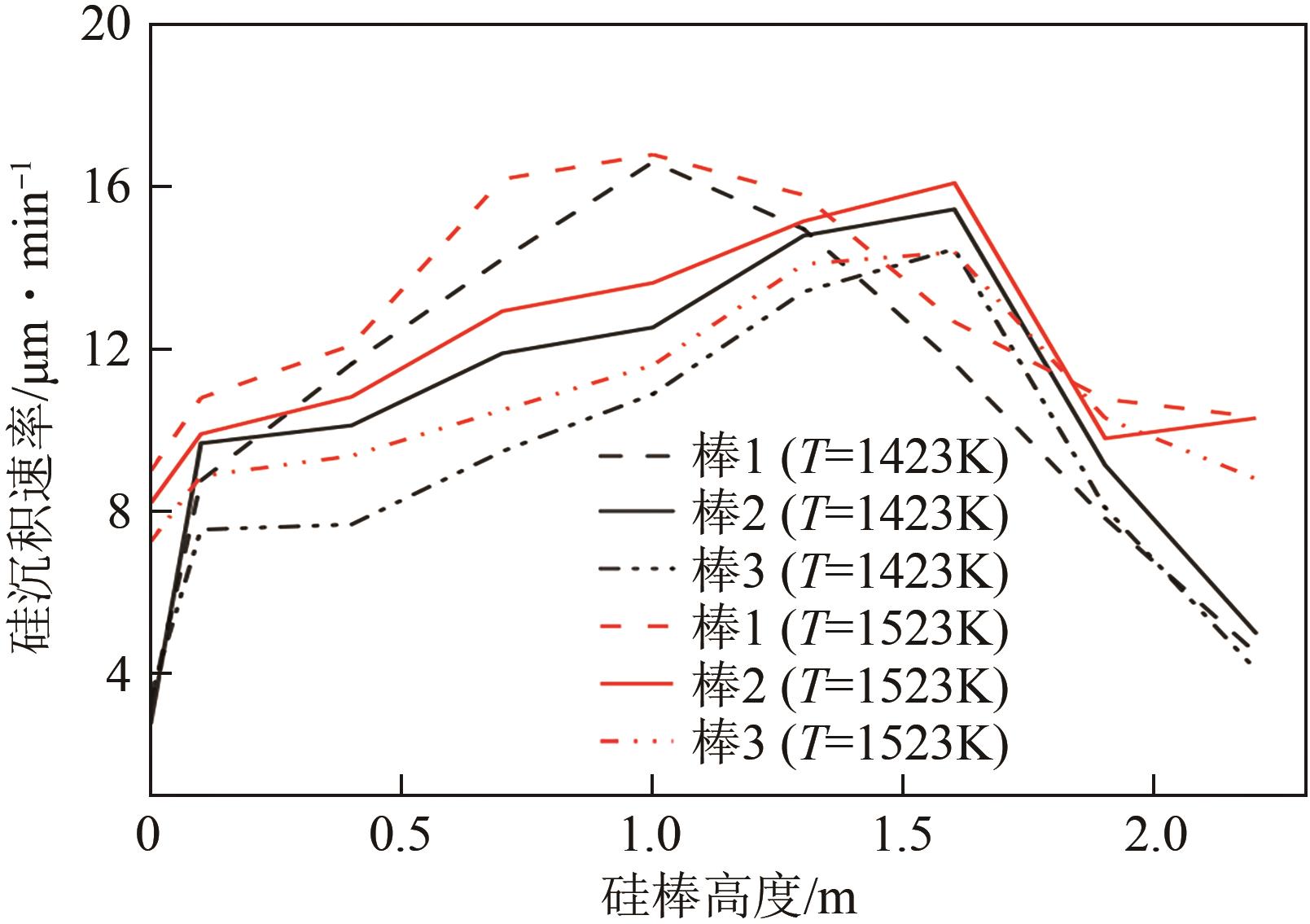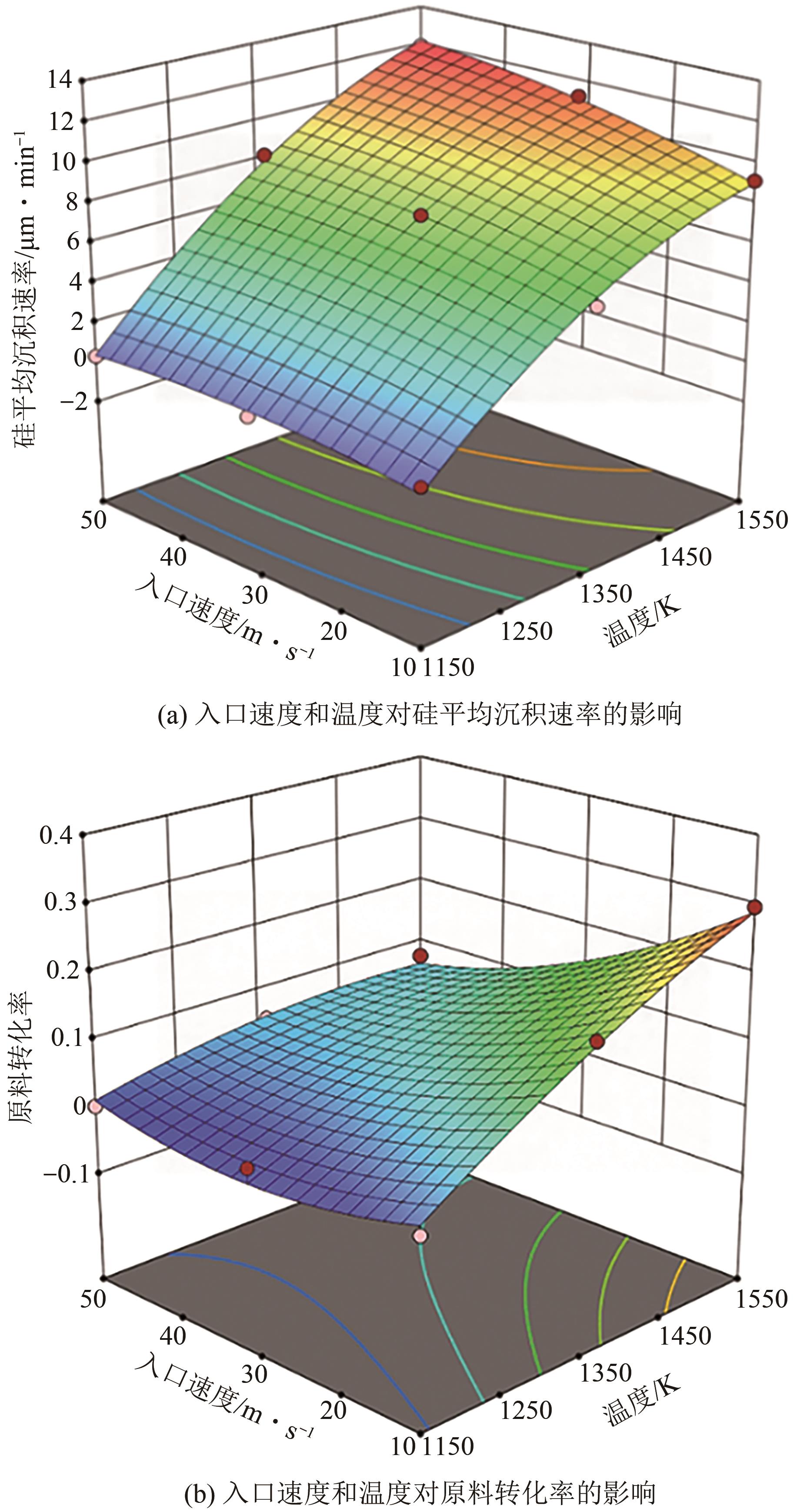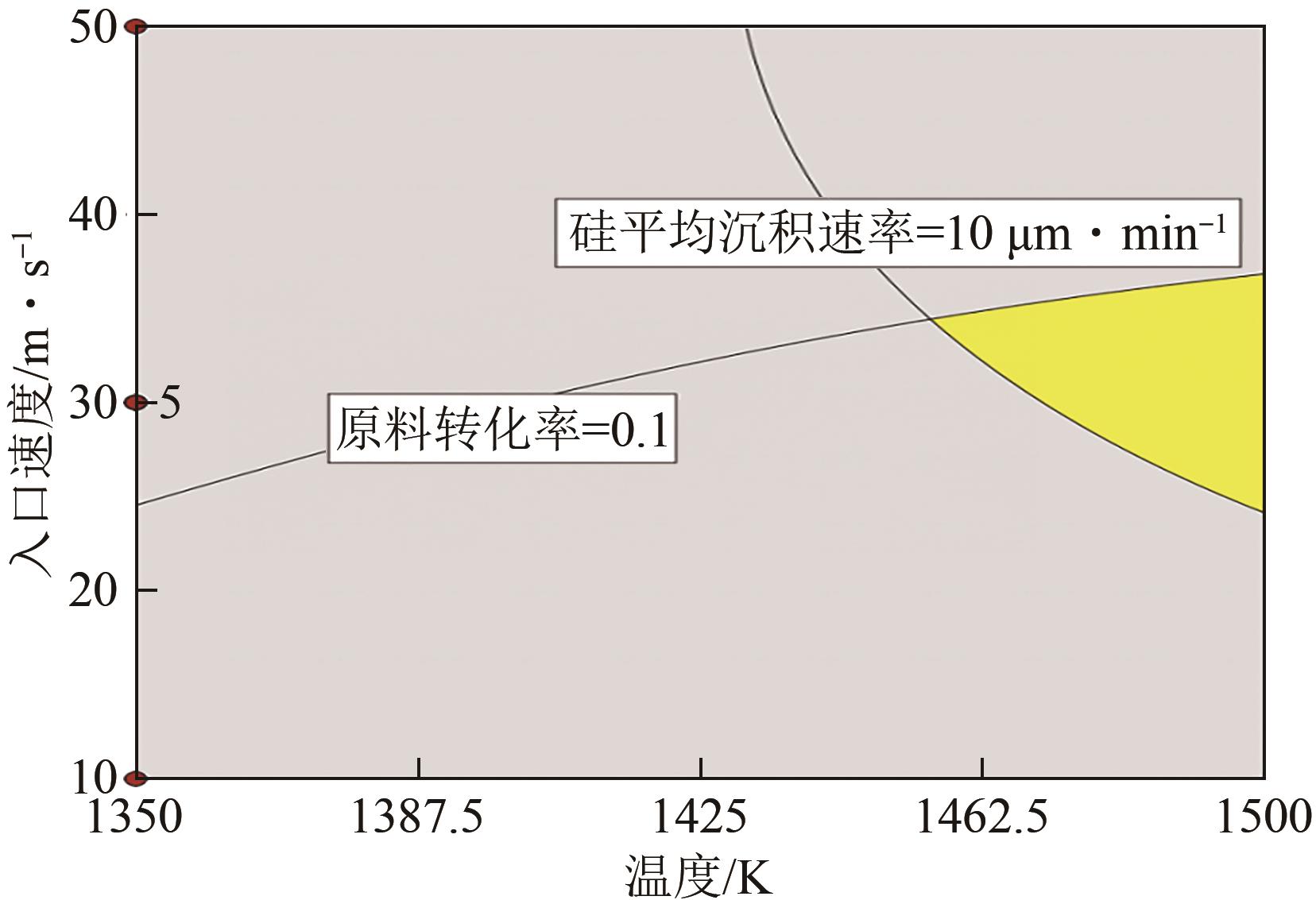Chemical Industry and Engineering Progress ›› 2025, Vol. 44 ›› Issue (2): 706-716.DOI: 10.16085/j.issn.1000-6613.2024-0296
• Chemical processes and equipment • Previous Articles Next Articles
Numerical simulation of chemical vapor deposition in polycrystalline silicon reduction furnace
WANG Siyi1( ), XU Jianliang1, DAI Zhenghua1,2(
), XU Jianliang1, DAI Zhenghua1,2( ), WU Guoyi3, WANG Fuchen1
), WU Guoyi3, WANG Fuchen1
- 1.Shanghai Coal Gasification Engineering Technology Research Center, East China University of Science and Technology, Shanghai 200237, China
2.College of Chemical Engineering, Xinjiang University, Urumqi 830046, Xinjiang, China
3.Lanzhou Lanshi Heavy Equipment Co. , Ltd. , Lanzhou 730300, Gansu, China
-
Received:2024-02-20Revised:2024-03-29Online:2025-03-10Published:2025-02-25 -
Contact:DAI Zhenghua
多晶硅还原炉气相沉积反应数值模拟
王思懿1( ), 许建良1, 代正华1,2(
), 许建良1, 代正华1,2( ), 武国义3, 王辅臣1
), 武国义3, 王辅臣1
- 1.华东理工大学上海煤气化工程技术研究中心,上海 200237
2.新疆大学化工学院,新疆 乌鲁木齐 830046
3.兰州兰石重型装备股份有限公司,甘肃 兰州 730300
-
通讯作者:代正华 -
作者简介:王思懿(1999—),女,硕士研究生,研究方向为多晶硅反应过程模拟优化。E-mail:1072474707@qq.com。 -
基金资助:国家重点研发计划(2022YFB4101500);新疆维吾尔自治区自然科学基金重点项目(2023D01D02);中央高校基本科研业务费专项资金(2022ZFJH04)
CLC Number:
Cite this article
WANG Siyi, XU Jianliang, DAI Zhenghua, WU Guoyi, WANG Fuchen. Numerical simulation of chemical vapor deposition in polycrystalline silicon reduction furnace[J]. Chemical Industry and Engineering Progress, 2025, 44(2): 706-716.
王思懿, 许建良, 代正华, 武国义, 王辅臣. 多晶硅还原炉气相沉积反应数值模拟[J]. 化工进展, 2025, 44(2): 706-716.
share this article
Add to citation manager EndNote|Ris|BibTeX
URL: https://hgjz.cip.com.cn/EN/10.16085/j.issn.1000-6613.2024-0296
| 序号 | 反应 | A/s-1 | E/cal·mol-1 |
|---|---|---|---|
| G1 | SiHCl3 | 3.162×1014 | 72900 |
| G2 | SiH2Cl2 | 3.162×1013 | 69300 |
| G3 | SiH2Cl2 | 6.918×1014 | 75800 |
| G4 | H2ClSiSiCl3 | 1.585×1013 | 55500 |
| G5 | H2ClSiSiCl3 | 3.162×1013 | 49800 |
| G6 | H2ClSiSiCl3 | 6.310×1013 | 44300 |
| G7 | Si2HCl5 | 5.012×1013 | 52300 |
| G8 | Si2HCl5 | 7.943×1013 | 45900 |
| G9 | Si2Cl6 | 1.585×1014 | 48800 |
| 序号 | 反应 | A/s-1 | E/cal·mol-1 |
|---|---|---|---|
| G1 | SiHCl3 | 3.162×1014 | 72900 |
| G2 | SiH2Cl2 | 3.162×1013 | 69300 |
| G3 | SiH2Cl2 | 6.918×1014 | 75800 |
| G4 | H2ClSiSiCl3 | 1.585×1013 | 55500 |
| G5 | H2ClSiSiCl3 | 3.162×1013 | 49800 |
| G6 | H2ClSiSiCl3 | 6.310×1013 | 44300 |
| G7 | Si2HCl5 | 5.012×1013 | 52300 |
| G8 | Si2HCl5 | 7.943×1013 | 45900 |
| G9 | Si2Cl6 | 1.585×1014 | 48800 |
| 序号 | 反应 | A/s-1 | E/cal·mol-1 |
|---|---|---|---|
| S1 | SiHCl3+4Si(s) | 4.1×10-4 | -3800 |
| S2 | SiH2Cl2+4Si(s) | 1.2×10-3 | -3800 |
| S3 | SiCl4+4Si(s) | 3.0×10-5 | -3800 |
| S4 | SiCl2+2Si(s) | 2.2 | 15000 |
| S5 | 2SiCl(s)+Si(b) | 4.758×1022 | 67000 |
| S6 | H2+2Si(s) | 0.1 | 17300 |
| S7 | 2SiH(s) | 8.606×1022 | 57100 |
| S8 | HCl+2Si(s) | 0.07 | 5000 |
| S9 | SiH(s)+SiCl(s) | 4.0×1025 | 71500 |
| S10 | SiHCl+2Si(s) | 0.06 | 5000 |
| 序号 | 反应 | A/s-1 | E/cal·mol-1 |
|---|---|---|---|
| S1 | SiHCl3+4Si(s) | 4.1×10-4 | -3800 |
| S2 | SiH2Cl2+4Si(s) | 1.2×10-3 | -3800 |
| S3 | SiCl4+4Si(s) | 3.0×10-5 | -3800 |
| S4 | SiCl2+2Si(s) | 2.2 | 15000 |
| S5 | 2SiCl(s)+Si(b) | 4.758×1022 | 67000 |
| S6 | H2+2Si(s) | 0.1 | 17300 |
| S7 | 2SiH(s) | 8.606×1022 | 57100 |
| S8 | HCl+2Si(s) | 0.07 | 5000 |
| S9 | SiH(s)+SiCl(s) | 4.0×1025 | 71500 |
| S10 | SiHCl+2Si(s) | 0.06 | 5000 |
| 参数 | 数值 |
|---|---|
| 反应器高度/mm | 3500 |
| 反应器直径/mm | 1600 |
| 入口直径/mm | 20 |
| 出口直径/mm | 200 |
| 硅棒高度/mm | 2300 |
| 硅棒直径/mm | 110 |
| 硅棒间距/mm | 235 |
| 参数 | 数值 |
|---|---|
| 反应器高度/mm | 3500 |
| 反应器直径/mm | 1600 |
| 入口直径/mm | 20 |
| 出口直径/mm | 200 |
| 硅棒高度/mm | 2300 |
| 硅棒直径/mm | 110 |
| 硅棒间距/mm | 235 |
| 参数 | 数值 |
|---|---|
| 入口 | 入口速度(18m/s、36m/s) |
| 出口 | 出口压力 |
| 原料摩尔比 | H2∶TCS=4∶1 (413K) |
| 硅棒表面温度 | 1423K,1523K |
| 炉壁温度 | 500K |
| 操作压力 | 6atm |
| 表面反射率 | 硅棒0.7,其他0.5 |
| 参数 | 数值 |
|---|---|
| 入口 | 入口速度(18m/s、36m/s) |
| 出口 | 出口压力 |
| 原料摩尔比 | H2∶TCS=4∶1 (413K) |
| 硅棒表面温度 | 1423K,1523K |
| 炉壁温度 | 500K |
| 操作压力 | 6atm |
| 表面反射率 | 硅棒0.7,其他0.5 |
| 来源 | 反应器规模 | 沉积表面温度/K | 操作压力/atm | H2∶TCS原料摩尔比 | 单根硅棒产量/kg |
|---|---|---|---|---|---|
| 夏小霞等[ | 单根棒 | 1373 | 6 | 4∶1 | 122 |
| 张胜涛[ | 9对棒 | 1323 | 6 | 2.5∶1 | 260 |
| Li等[ | 12对棒 | 1148 | 3 | 2.8∶1 | 135 |
| 倪昊尹等[ | 12对棒 | 1473 | 3 | 3.1∶1 | 340 |
| 张弘[ | 24对棒 | 1353 | 5 | 3.5∶1 | 93 |
| 王体虎等[ | 48对棒 | 1223 | 4 | 4∶1 | 125 |
| 本文 | 12对棒 | 1423 | 6 | 4∶1 | 148 |
| 来源 | 反应器规模 | 沉积表面温度/K | 操作压力/atm | H2∶TCS原料摩尔比 | 单根硅棒产量/kg |
|---|---|---|---|---|---|
| 夏小霞等[ | 单根棒 | 1373 | 6 | 4∶1 | 122 |
| 张胜涛[ | 9对棒 | 1323 | 6 | 2.5∶1 | 260 |
| Li等[ | 12对棒 | 1148 | 3 | 2.8∶1 | 135 |
| 倪昊尹等[ | 12对棒 | 1473 | 3 | 3.1∶1 | 340 |
| 张弘[ | 24对棒 | 1353 | 5 | 3.5∶1 | 93 |
| 王体虎等[ | 48对棒 | 1223 | 4 | 4∶1 | 125 |
| 本文 | 12对棒 | 1423 | 6 | 4∶1 | 148 |
| 变量 | 水平 | ||
|---|---|---|---|
| -1 | 0 | 1 | |
| A-温度T/K | 1150 | 1350 | 1550 |
| B-入口速度v/m·s-1 | 10 | 30 | 50 |
| 变量 | 水平 | ||
|---|---|---|---|
| -1 | 0 | 1 | |
| A-温度T/K | 1150 | 1350 | 1550 |
| B-入口速度v/m·s-1 | 10 | 30 | 50 |
| 运行次数 | 温度T/K | 入口速度v/m·s-1 | 沉积速率 /μm·min-1 | 原料转化率 |
|---|---|---|---|---|
| 1 | 1350 | 50 | 8.180 | 0.053 |
| 2 | 1550 | 30 | 11.204 | 0.121 |
| 3 | 1350 | 30 | 7.462 | 0.081 |
| 4 | 1550 | 50 | 11.919 | 0.077 |
| 5 | 1150 | 30 | 0.352 | 0.004 |
| 6 | 1350 | 10 | 5.648 | 0.183 |
| 7 | 1350 | 30 | 7.462 | 0.081 |
| 8 | 1150 | 50 | 0.318 | 0.002 |
| 9 | 1350 | 30 | 7.462 | 0.081 |
| 10 | 1350 | 30 | 7.462 | 0.081 |
| 11 | 1550 | 10 | 9.142 | 0.297 |
| 12 | 1350 | 30 | 7.462 | 0.081 |
| 13 | 1150 | 10 | 0.309 | 0.010 |
| 运行次数 | 温度T/K | 入口速度v/m·s-1 | 沉积速率 /μm·min-1 | 原料转化率 |
|---|---|---|---|---|
| 1 | 1350 | 50 | 8.180 | 0.053 |
| 2 | 1550 | 30 | 11.204 | 0.121 |
| 3 | 1350 | 30 | 7.462 | 0.081 |
| 4 | 1550 | 50 | 11.919 | 0.077 |
| 5 | 1150 | 30 | 0.352 | 0.004 |
| 6 | 1350 | 10 | 5.648 | 0.183 |
| 7 | 1350 | 30 | 7.462 | 0.081 |
| 8 | 1150 | 50 | 0.318 | 0.002 |
| 9 | 1350 | 30 | 7.462 | 0.081 |
| 10 | 1350 | 30 | 7.462 | 0.081 |
| 11 | 1550 | 10 | 9.142 | 0.297 |
| 12 | 1350 | 30 | 7.462 | 0.081 |
| 13 | 1150 | 10 | 0.309 | 0.010 |
| 方差来源 | 平方和 | 自由度 | 均方差 | F | P | 显著性 |
|---|---|---|---|---|---|---|
| 总模型 | 180.39 | 5 | 36.08 | 426.41 | <0.0001 | 显著 |
| A | 163.13 | 1 | 163.13 | 1927.97 | <0.0001 | 显著 |
| B | 4.72 | 1 | 4.72 | 55.73 | 0.0001 | 显著 |
| AB | 1.92 | 1 | 1.92 | 22.64 | 0.0021 | 显著 |
| A² | 6.99 | 1 | 6.99 | 82.67 | <0.0001 | 显著 |
| B² | 0.5720 | 1 | 0.5720 | 6.76 | 0.0354 | 显著 |
| 残差 | 0.5923 | 7 | 0.0846 | |||
| 失拟项 | 0.5923 | 3 | 0.1974 | |||
| 纯误差 | 0.0000 | 4 | 0.0000 | |||
| 总和 | 180.99 | 12 | ||||
| R2=0.9967,R2(校正)=0.9944 | ||||||
| 方差来源 | 平方和 | 自由度 | 均方差 | F | P | 显著性 |
|---|---|---|---|---|---|---|
| 总模型 | 180.39 | 5 | 36.08 | 426.41 | <0.0001 | 显著 |
| A | 163.13 | 1 | 163.13 | 1927.97 | <0.0001 | 显著 |
| B | 4.72 | 1 | 4.72 | 55.73 | 0.0001 | 显著 |
| AB | 1.92 | 1 | 1.92 | 22.64 | 0.0021 | 显著 |
| A² | 6.99 | 1 | 6.99 | 82.67 | <0.0001 | 显著 |
| B² | 0.5720 | 1 | 0.5720 | 6.76 | 0.0354 | 显著 |
| 残差 | 0.5923 | 7 | 0.0846 | |||
| 失拟项 | 0.5923 | 3 | 0.1974 | |||
| 纯误差 | 0.0000 | 4 | 0.0000 | |||
| 总和 | 180.99 | 12 | ||||
| R2=0.9967,R2(校正)=0.9944 | ||||||
| 方差来源 | 平方和 | 自由度 | 均方差 | F | P | 显著性 |
|---|---|---|---|---|---|---|
| 总模型 | 0.0745 | 5 | 0.0149 | 71.60 | <0.0001 | 显著 |
| A | 0.0382 | 1 | 0.0382 | 183.88 | <0.0001 | 显著 |
| B | 0.0213 | 1 | 0.0213 | 102.58 | <0.0001 | 显著 |
| AB | 0.0112 | 1 | 0.0112 | 53.79 | 0.0002 | 显著 |
| A² | 0.0011 | 1 | 0.0011 | 5.24 | 0.0559 | 不显著 |
| B² | 0.0036 | 1 | 0.0036 | 17.14 | 0.0043 | 显著 |
| 残差 | 0.0015 | 7 | 0.0002 | |||
| 失拟项 | 0.0.0015 | 3 | 0.0005 | |||
| 纯误差 | 0.0759 | 4 | 0.0000 | |||
| 总和 | 180.99 | 12 | ||||
| R2=0.9808,R2(校正)=0.9671 | ||||||
| 方差来源 | 平方和 | 自由度 | 均方差 | F | P | 显著性 |
|---|---|---|---|---|---|---|
| 总模型 | 0.0745 | 5 | 0.0149 | 71.60 | <0.0001 | 显著 |
| A | 0.0382 | 1 | 0.0382 | 183.88 | <0.0001 | 显著 |
| B | 0.0213 | 1 | 0.0213 | 102.58 | <0.0001 | 显著 |
| AB | 0.0112 | 1 | 0.0112 | 53.79 | 0.0002 | 显著 |
| A² | 0.0011 | 1 | 0.0011 | 5.24 | 0.0559 | 不显著 |
| B² | 0.0036 | 1 | 0.0036 | 17.14 | 0.0043 | 显著 |
| 残差 | 0.0015 | 7 | 0.0002 | |||
| 失拟项 | 0.0.0015 | 3 | 0.0005 | |||
| 纯误差 | 0.0759 | 4 | 0.0000 | |||
| 总和 | 180.99 | 12 | ||||
| R2=0.9808,R2(校正)=0.9671 | ||||||
| 1 | 邱祥海. 四氯化硅再利用技术的研究进展[J]. 能源化工, 2023, 44(3): 1-5. |
| QIU Xianghai. Research progress of the reuse technology of silicon tetrachloride[J]. Energy Chemical Industry, 2023, 44(3): 1-5. | |
| 2 | HALLAM Brett, KIM Moonyong, UNDERWOOD Robert, et al. A polysilicon learning curve and the material requirements for broad electrification with photovoltaics by 2050[J]. Solar RRL, 2022, 6(10): 2200458. |
| 3 | MITIN V V, KOKH A A. Polysilicon market development and production technologies[J]. Russian Microelectronics, 2018, 47(8): 553-558. |
| 4 | BRAGA A F B, MOREIRA S P, ZAMPIERI P R, et al. New processes for the production of solar-grade polycrystalline silicon: A review[J]. Solar Energy Materials and Solar Cells, 2008, 92(4): 418-424. |
| 5 | ZHANG Pan, CHEN Guanghui, WANG Weiwen, et al. Influence of water-cooled jacket on polysilicon CVD, fines formation and thermal loss in komatsu reactor[J]. ECS Journal of Solid State Science and Technology, 2019, 8(10): P615-P621. |
| 6 | 张鹏远, 杜俊平. 结合多晶硅国家标准浅析电子级多晶硅生产控制要点[J]. 中国有色冶金, 2021, 50(2): 59-63. |
| ZHANG Pengyuan, DU Junping. Manufacture process control of electronic grade polysilicon based on the polysilicon national standard[J]. China Nonferrous Metallurgy, 2021, 50(2): 59-63. | |
| 7 | 张鹏远, 杜俊平. 改良西门子法多晶硅产品质量控制措施探究[J]. 中国有色冶金, 2020, 49(2): 55-57. |
| ZHANG Pengyuan, DU Junping. Improvement measures for polysilicon products quality by improved Siemens method[J]. China Nonferrous Metallurgy, 2020, 49(2): 55-57. | |
| 8 | 黄凯, 黄河, 刘娜, 等. 基于48对棒CVD还原炉出口的CFD模拟[J]. 化学工程, 2023, 51(10): 79-82, 88. |
| HUANG Kai, HUANG He, LIU Na, et al. CFD simulation of outlet of 48-pair rod CVD reduction furnace[J]. Chemical Engineering (China), 2023, 51(10): 79-82, 88. | |
| 9 | LIU Yingwen, AN Lisha, WU Renjie. Analysis of radiative energy loss in a polysilicon CVD reactor using Monte Carlo ray tracing method[J]. Applied Thermal Engineering, 2016, 93: 269-278. |
| 10 | RAMOS A, DEL CAÑIZO C, VALDEHITA J, et al. Radiation heat savings in polysilicon production: Validation of results through a CVD laboratory prototype[J]. Journal of Crystal Growth, 2013, 374: 5-10. |
| 11 | ZHANG Pan, WANG Weiwen, CHENG Guanghui, et al. Effect of boundary layers on polycrystalline silicon chemical vapor deposition in a trichlorosilane and hydrogen system[J]. Chinese Journal of Chemical Engineering, 2011, 19(1): 1-9. |
| 12 | 杨楠, 杨志国, 施汉文, 等. 不同出气方式时多晶硅还原炉内的流场和热场模拟[J]. 太阳能, 2020(7): 42-47. |
| YANG Nan, YANG Zhiguo, SHI Hanwen, et al. Simulation of flow field and thermal field of polysilicon reduction furnace with different gas outlet methods[J]. Solar Energy, 2020(7): 42-47. | |
| 13 | 王品杰. 多场耦合作用下多晶硅还原炉能量耗散机理研究[D]. 昆明: 昆明理工大学, 2021. |
| WANG Pinjie. Study on energy dissipation mechanism of polysilicon reduction furnace under multi-field coupling[D]. Kunming: Kunming University of Science and Technology, 2021. | |
| 14 | LI Xuegang, XIAO Wende. Silane pyrolysis to silicon rod in a bell-jar reactor at high temperature and pressure: Modeling and simulation[J]. Industrial & Engineering Chemistry Research, 2016, 55(17): 4887-4896. |
| 15 | Pauline HO, BALAKRISHNA Ajit, CHACIN Juan M, et al Chemical kinetics for modeling silicon epitaxy from chlorosilanes[C]//194th Meeting of the Electrochemical Society. Albuquerque: Sandia National Laboratories, 1998. |
| 16 | HABUKA Hitoshi, AOYAMA Yasuaki, AKIYAMA Shoji, et al. Chemical process of silicon epitaxial growth in a SiHCl3-H2 system[J]. Journal of Crystal Growth, 1999, 207(1/2): 77-86. |
| 17 | CUI Yong, WANG Yiping, HUANG Qunwu, et al. Effect of radiation and convection heat transfer on cooling performance of radiative panel[J]. Renewable Energy, 2016, 99: 10-17. |
| 18 | 夏小霞, 周乃君, 王志奇. 多晶硅化学气相沉积反应的三维数值模拟[J]. 人工晶体学报, 2014, 43(3): 569-575. |
| XIA Xiaoxia, ZHOU Naijun, WANG Zhiqi. Three-dimensional numerical simulation of chemical vapor deposition of polysilicon[J]. Journal of Synthetic Crystals, 2014, 43(3): 569-575. | |
| 19 | 张胜涛. 基于数值模拟电子级多晶硅生长还原炉耦合工艺研究[D]. 哈尔滨: 哈尔滨工业大学, 2019. |
| ZHANG Shengtao. Study on coupling technology of electronic grade polysilicon growth reactor based on numerical simulation[D]. Harbin: Harbin Institute of Technology, 2019. | |
| 20 | LI Xuegang, XIAO Wende. Model on transport phenomena and control of rod growth uniformity in siemens CVD reactor[J]. Computers & Chemical Engineering, 2018, 117: 351-358. |
| 21 | 倪昊尹, 陈彩霞. 多晶硅化学气相沉积过程气相与表面反应模拟验证[J]. 人工晶体学报, 2015, 44(11): 3083-3089. |
| NI Haoyin, CHEN Caixia. Numerical validation of gas and surface reactions for the polysilicon chemical vapor deposition process[J]. Journal of Synthetic Crystals, 2015, 44(11): 3083-3089. | |
| 22 | 张弘. 24对棒多晶硅工艺优化与研究[D]. 天津: 天津大学, 2016. |
| ZHANG Hong. Optimization and research of 24 pair rod polycrystalline silicon process[D]. Tianjin: Tianjin University, 2016. | |
| 23 | 王体虎, 宗冰, 蔡延国, 等. 48对棒大型还原炉设计开发与应用研究[J]. 青海科技, 2017, 24(4): 12-16. |
| WANG Tihu, ZONG Bing, CAI Yanguo, et al. Research on design, development and application of 48 pairs of large reduction furnaces[J]. Qinghai Science and Technology, 2017, 24(4): 12-16. | |
| 24 | 李国栋. 基于Gibbs自由能最小法的反应过程优化设计的研究[D]. 青岛: 中国海洋大学, 2007. |
| LI Guodong. Study on optimal design of reaction process based on Gibbs free energy minimization method[D]. Qingdao: Ocean University of China, 2007. | |
| 25 | AN Lisha, LIU Chunjiao, LIU Yingwen. Optimization of operating parameters in polysilicon chemical vapor deposition reactor with response surface methodology[J]. Journal of Crystal Growth, 2018, 489: 11-19. |
| 26 | ZHANG Shuhang, DAI Zhenghua, XU Jianliang, et al. Sensitivity and safety boundary analysis of opposed multi-burner coal water slurry gasification system[J]. International Journal of Energy Research, 2020, 44(3): 2278-2288. |
| 27 | WANG Qili, JIA Binbin, YU Mingquan, et al. Numerical simulation of the flow and erosion behavior of exhaust gas and particles in polysilicon reduction furnace[J]. Scientific Reports, 2020, 10(1): 1909. |
| [1] | ZHANG Zhe, JI Xianbing, YANG Yuhao, LIU Jiaxuan, YAO Bocheng. Boiling heat transfer performance on multiscale structure sintered groove surface [J]. Chemical Industry and Engineering Progress, 2025, 44(2): 669-676. |
| [2] | HU Panpan, XIAO Mengyao, WANG Na, SHI Jiping, LIU Li. Optimization of multi-enzyme collaborative pretreatment of kitchen waste [J]. Chemical Industry and Engineering Progress, 2025, 44(2): 1138-1146. |
| [3] | XIONG Siheng, HUANG Dongmei, XIAO Yuan, HUANG Xiaohuang, YI Zhikang, CUI Guomin. Novel continuous non-structural model for mass exchanger network synthesis [J]. Chemical Industry and Engineering Progress, 2025, 44(2): 635-645. |
| [4] | SUN Yuepeng, SUN Yanji, PAN Yanqiu, WANG Chengyu. Prediction of CO2 content in Rectisol purified gas based on BO-LSTM [J]. Chemical Industry and Engineering Progress, 2025, 44(2): 688-697. |
| [5] | HUANG Zhengfeng, WANG Heng, HONG Hao, ZHU Guorui. Characterization of vortex shedding in concentric circular transition arrangement tube bundles [J]. Chemical Industry and Engineering Progress, 2025, 44(2): 698-705. |
| [6] | SU Xuanhe, MENG Shida, KE Jiekun, LU Wei. Analyses of performance and energy consumption for a multistage gas separation system based on molecular exchange flow [J]. Chemical Industry and Engineering Progress, 2025, 44(1): 109-120. |
| [7] | XIAO Yuan, CHEN Yi, LIU Siqi, CUI Guomin. Mass-heat analogy and global optimization of mass exchange network based on generalized heat exchanger network [J]. Chemical Industry and Engineering Progress, 2025, 44(1): 121-134. |
| [8] | QIAO Lei, ZHANG Yaxin, WEI Bo, RAN Wenshen, MA Jingrong, WANG Feng. Optimization of burner layout parameters and operating parameters of oxy-thermal entrained-flow calcium carbide reactor [J]. Chemical Industry and Engineering Progress, 2025, 44(1): 145-157. |
| [9] | XU Yang, YANG Qizhou, PAN Yueyue, ZHOU Yongjun. Flow field characteristics in stirred tank equipped with punched and four-pitched blade combined impeller [J]. Chemical Industry and Engineering Progress, 2025, 44(1): 38-47. |
| [10] | CAI Kainan, CHEN Jianyong, CHEN Ying, LUO Xianglong, LIANG Yingzong, HE Jiacheng. Thermodynamic performance of zeotropic mixtures in liquid-vapor separation plate condenser [J]. Chemical Industry and Engineering Progress, 2025, 44(1): 48-56. |
| [11] | LI Hao, SUN Yunan, LI Jian, TAO Junyu, CHENG Zhanjun, YAN Beibei, CHEN Guanyi. Co-gasification characteristics of excavated waste and municipal solid waste blends [J]. Chemical Industry and Engineering Progress, 2025, 44(1): 525-537. |
| [12] | SUN Jianchen, YANG Jie, LI Jun, SUN Huidong, NIU Junmin, LIAO Yifei, REN Junying, SHANG Hui. Effect of catalyst particle arrangements on microwave heating [J]. Chemical Industry and Engineering Progress, 2025, 44(1): 57-65. |
| [13] | ZHU Rukai, CHENG Xiao, LIU Jinya, WU Huiying. Flow and heat transfer characteristics and multi-objective optimization of pin-fin multi inclined jet microchannels [J]. Chemical Industry and Engineering Progress, 2025, 44(1): 86-99. |
| [14] | DAI Zhengshu, ZUO Yuanhao, CHEN Xiaoluo, ZHANG Li, ZHAO Gen, ZHANG Xuejun, ZHANG Hua. Process in the application of machine learning in ejector research [J]. Chemical Industry and Engineering Progress, 2024, 43(S1): 1-12. |
| [15] | ZHANG Tianhao, LI Shuangxi, JIA Xiangji, HU Dingguo, CUI Ruizhuo, LI Shicong. Analysis of the effect of thermal deformation and friction wear of reinforced DLC film on the end face of high-speed mechanical seals [J]. Chemical Industry and Engineering Progress, 2024, 43(S1): 121-133. |
| Viewed | ||||||
|
Full text |
|
|||||
|
Abstract |
|
|||||
